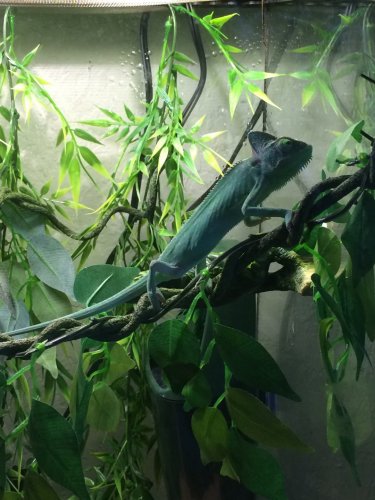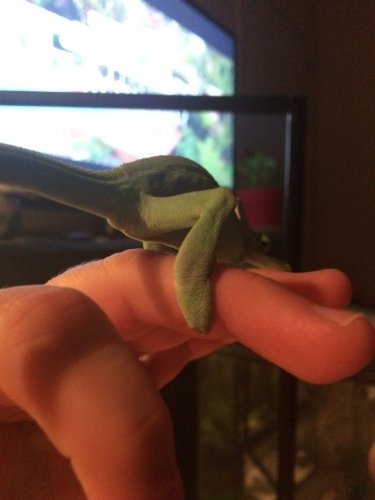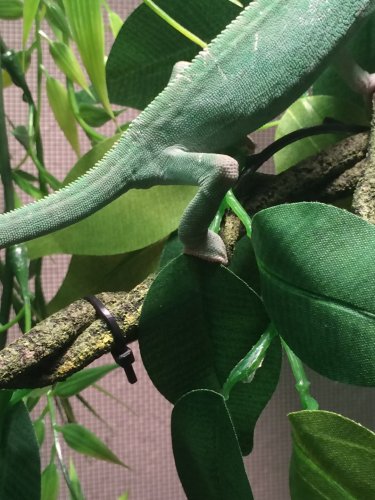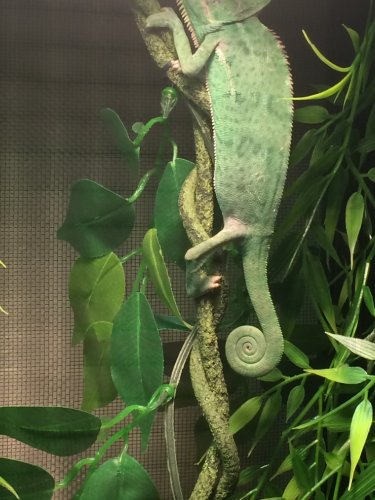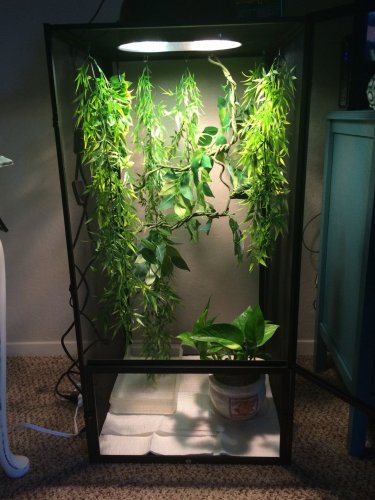Navigation
Install the app
How to install the app on iOS
Follow along with the video below to see how to install our site as a web app on your home screen.
Note: This feature may not be available in some browsers.
More options
You are using an out of date browser. It may not display this or other websites correctly.
You should upgrade or use an alternative browser.
You should upgrade or use an alternative browser.
Starting to doubt the sex
- Thread starter Kclarke02
- Start date
jpowell86
Chameleon Enthusiast
Based on the pic I attach, does this look male or female?? I was told Bosco was a male but upon further inspection, I'm starting to doubt!!! I don't really see Spurs on the back feet....
If you can get me a pic of the backside of the back feet, I can tell you real quick.
Kclarke02
Avid Member
About the laying bin, what do I use as bedding?? I've never really looked into that.Definitely a female. No biggie. Just lower temps, a laying bin and fewer feeders.
Kclarke02
Avid Member
Ironically, today I just got a new one, it's a Reptibreeze, large, 18x18x36. She doesn't venture out vertically as much, but I had noticed that she's ventured to the bottom the past couple of days. I thought that was weird for a male. That's what got me looking at her more closelyI personally use a mixture of coco fiber and sand. I don't put a bin inside the corner of a cage like most. I get bins that fit the enclosure bottom. What kind of enclosure do you have her in?
jpowell86
Chameleon Enthusiast
Not a stupid question at all. I get mine from home depot, lowes or anything similar. I just get the playsand. I wash it thoroughly and then mix it almost 50/50 with the coco fiber. Try getting a bin that will take up the majority if not all the bottom of your enclosure. You want it to be at least 6-8 inches deep. Some dig deep, some lay shallow. You never know. It is more precautionary.
You will definitely know when she is gravid and when it is time. Nothing too startling about the process. But, not being prepared is where most novice run into problems with dystocia and general declines in health. Just read material and previous posts about what is needed when dealing with a gravid veiled female.
Feeding smaller amounts will help reduce clutch size therefore extending the life of your animal. But....do not do this right now. At this age she needs all the nutrients she can get for proper development. Once she is at the 9-12 month range, start slowly reducing her intake.
I guess that was more information than you asked for....sorry!
You will definitely know when she is gravid and when it is time. Nothing too startling about the process. But, not being prepared is where most novice run into problems with dystocia and general declines in health. Just read material and previous posts about what is needed when dealing with a gravid veiled female.
Feeding smaller amounts will help reduce clutch size therefore extending the life of your animal. But....do not do this right now. At this age she needs all the nutrients she can get for proper development. Once she is at the 9-12 month range, start slowly reducing her intake.
I guess that was more information than you asked for....sorry!
Kclarke02
Avid Member
That was exactly what I was needing to hear! Thank you so much. She's about 6 months now and will eat as much as I give her. I just got a little dripper so she drinks a lot. She will eat as many crickets as she can get, and she had 2 small hornworms today, which she loved. im so attached to her already, tmrw makes 3 weeks that I've had her. Just got some repashy gutload today and her crickets are feeding on it as we speak....Not a stupid question at all. I get mine from home depot, lowes or anything similar. I just get the playsand. I wash it thoroughly and then mix it almost 50/50 with the coco fiber. Try getting a bin that will take up the majority if not all the bottom of your enclosure. You want it to be at least 6-8 inches deep. Some dig deep, some lay shallow. You never know. It is more precautionary.
You will definitely know when she is gravid and when it is time. Nothing too startling about the process. But, not being prepared is where most novice run into problems with dystocia and general declines in health. Just read material and previous posts about what is needed when dealing with a gravid veiled female.
Feeding smaller amounts will help reduce clutch size therefore extending the life of your animal. But....do not do this right now. At this age she needs all the nutrients she can get for proper development. Once she is at the 9-12 month range, start slowly reducing her intake.
I guess that was more information than you asked for....sorry!
Kclarke02
Avid Member
Ok good deal, that's what I've seen so far...to feed them as much as they want. I just want her to be happy and healthy. She's only had 3 hornworms in her life but really loves them! She's so cute, gets SO excited about food haha!! I love her8 medium crickets and 2 hornworms is great! I always let them eat whatever they want at that age!
MeruJack
Avid Member
Here's some info about female Veiled chameleons.
Veiled Chameleon General Care
Temperature:
Baby/juvenile (<9 months): ambient 72-80F (22-26C), basking 85F (29C)
Adult females: ambient 75-80F (23-26C), basking 85F (29C)
Feeding:
Neonates: as many small crickets as they can eat several times a day
Juveniles 3-6 months of age: 10-12 small crickets daily
Juveniles 6-12 months of age: 10-12 medium crickets every other day
Adults over 12 months of age: 7-10 medium-large crickets every other day
Cage Size:
screen cage (length x width x height):
juveniles/sub-adults : 16x16x30"
adult female minimum: 18x18x36"
Egg Laying:
“A female over 6 months of age should always have a laying bin available. The laying bin should be at least 16x16x16" with depth of substrate of at least 12" being crucial. The egg laying substrate should be either washed playsand or a mixture of washed playsand and organic soil moistened so that a tunnel retains its shape and does not collapse. There should be one or several branches going into the laying bin so that the female can crawl in and out as desired. A female about to lay eggs will often become restless, pace her cage and make decrease or stop eating in the week before. Once a female enters the laying bin she may dig several test holes before choosing to lay eggs. They dig head first to make the tunnel and then back into the tunnel to lay their eggs before covering the tunnel completely. It is absolutely critical to give a chameleon complete privacy while she is in the laying bin.”
All above info from Chameleon Forum Caresheet located at: https://www.chameleonforums.com/care/caresheets/veiled/
Good luck with your little girl!!
Veiled Chameleon General Care
Temperature:
Baby/juvenile (<9 months): ambient 72-80F (22-26C), basking 85F (29C)
Adult females: ambient 75-80F (23-26C), basking 85F (29C)
Feeding:
Neonates: as many small crickets as they can eat several times a day
Juveniles 3-6 months of age: 10-12 small crickets daily
Juveniles 6-12 months of age: 10-12 medium crickets every other day
Adults over 12 months of age: 7-10 medium-large crickets every other day
Cage Size:
screen cage (length x width x height):
juveniles/sub-adults : 16x16x30"
adult female minimum: 18x18x36"
Egg Laying:
“A female over 6 months of age should always have a laying bin available. The laying bin should be at least 16x16x16" with depth of substrate of at least 12" being crucial. The egg laying substrate should be either washed playsand or a mixture of washed playsand and organic soil moistened so that a tunnel retains its shape and does not collapse. There should be one or several branches going into the laying bin so that the female can crawl in and out as desired. A female about to lay eggs will often become restless, pace her cage and make decrease or stop eating in the week before. Once a female enters the laying bin she may dig several test holes before choosing to lay eggs. They dig head first to make the tunnel and then back into the tunnel to lay their eggs before covering the tunnel completely. It is absolutely critical to give a chameleon complete privacy while she is in the laying bin.”
All above info from Chameleon Forum Caresheet located at: https://www.chameleonforums.com/care/caresheets/veiled/
Good luck with your little girl!!
Similar threads
- Replies
- 4
- Views
- 243

